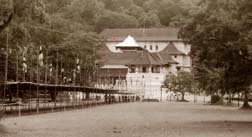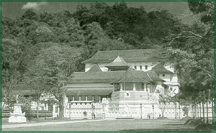
The Dalada Maligawa in Kandy where King Sri
Wickrema Rajasinghe envisioned himself as a god king, although his
subjects thought otherwise.
by Derrick Schokman
Daily News Fri Apr 25 2003
The Audience Hall or Magul Maduwa in the royal palace complex in Kandy was completed during the reign of King Sri Wickrema Rajasinghe, the last king of the independent Kandyan Kingdom.
|
|
It is opened on all four sides, with a hipped roof supported on four rows of carved halmilla pillars, rising from a stone stereobate.
The pillars at the head of the hall were spanned with relipalam arches and red curtains whenever the king held court. On one side of the hall would be seated the bhikkus (monks) and on the other the officers of the court.
To the accompaniment of music the red curtains would be drawn to reveal the king seated on his throne. He would be dressed all in white. Even the tasselled muthukuday held over his head would be white.
The monks would then chant a valedictory stanza and the ministers kneeling before him would wish him long life and ask for the blessings of the devas on him before the court finally went into session.
Treaty
When the king was captured by the British on 18 February, 1815 bringing to an end 2357 years of independence, the Kandyan Convention or treaty proceedings took place in the same hall but this time with Governor Robert Brownrigg presiding. The historic date was 2 March, 1815.
He received Maha Nilame Ehelapola, and the Dissawas led by Molligoda. Ehelepola, together with the wily John D'Oyly of the British Civil Service had engineered the coup which resulted in the fall of Kandy.
The treaty was read by D'Oyly in English and Mudaliyar de Saram in Sinhala declaring that Sri Wickrema Rajasinghe and all his family were forever excluded from the throne.
The Kandyans were assured that their new rulers would respect their laws, institutions and customs and that the religion of the Buddha would be inviolable.
Nobles who had assisted the British invasion were restored to the rule of their original provinces with the promise that their privileges and powers would be respected so long as they carried out their administration with the general policy of the British government.
Signatories to the Treaty were Governor Brownrigg, Ehelepola and the Dissawas Molligoda, Pilimatalawe the elder, Pilimatalawa Junior, Monerawila, Molligoda the younger, Dullewe, Ratwatte, Millawa, Galgama and Galegoda. The signatures were witnessed by D'Oyly, now British resident in Kandy and Deputy Secretary James Sutherland.
Two further conferences were held at the Audience Hall. One week later Governor Brownrigg received the Ven. Kobbekaduwa Mahanayaka Thera of Malwatte and the Ven. Yatawatte Mahanayaka Thera of Asgiriya. He gave them his personal assurance on behalf of the British Crown that the Sangha would be protected and the temples held sacred.
This conference was immediately followed by another to discuss with the chiefs the return of the sacred Dalada to the temple of the Tooth and the tutelary deities to their sanctuaries in the Devasanghinda.
Processions
In the very next month (April), the tutelary deities Natha, Vishnu, Pattini and Skanda (Kataragama) were welcomed back via the Gannoruwa ferry in a magnificent procession. An ever more magnificent procession attended the return of the Dalada in the following month of May. The mile long procession was headed by two standard bearers carrying the Buddhist flag and the Sinhala Rajakiya Dajaya (Sinhalese Royal Flag) having the figure of a lion holding a sword.
Behind them were eight gaily caparisoned tasked elephants, followed by the Venerable Maha Nayaka Theras of Malwatte and Asgiriya and 150 monks moving in single file according to their seniority of ordination.
An image of the Buddha under a canopy of sixty men carrying sixty banners followed together with dancing girls, drummers, conch blowers and other musicians.
A new feature added to this procession was the Ceylon Rifle Regiment of the British together with their drummers. Behind the soldiers was the Maligawa elephant carrying the Karanduwa with the Sacred Tooth Relic. Two tuskers on either side escorted the Maligawa elephant.
John D'Oyly, the Chiefs and the Headmen walked behind. Ehelapola who had pretensions of becoming king rode on horse back in the tradition of royalty. Envious chiefs whispered their suspicions in the ever ready ear of D'Oyly and Ehelapola was subsequently expelled by the British Government to Mauritius, where he died a much disillusioned person.
Deported
In 1816 the king and his dependents were deported to Fort Vellore in S. India as State prisoners. The king died in 1836 at the age of 52 after a prolonged illness. He left behind a son and two daughters.
His son, Rajadhi Rajasingha died in 1843 without issue. His two daughters followed in 1856 and 1860. Rajalakshmi Devi, wife of the king's grandson died in 1944. The last of his immediate descendants, C. K. Narasimha Raja died on October 6, 1948 thus ending Sri Lanka's last royal family.
Their graves lie forgotten in a cemetery at the Annanagar Colony in Vellore. The king's grave is in a walled enclosure, surrounded by seven other graves of his family members in a circle. The inscription on the king's tombstone reads as follows:
"His Majesty Sri Wickrema Raja Sinha last ex-king of Kandy, Ceylon. Died 1832". Is there anything left in Kandy to remind us of this King? Yes indeed there is the Octagon or Patthrippuwa (Lord's residence) where he would appear on ceremonial occasions. He had his architect Devendra Mulacharya built it modelled on the Mahameru Gala or cosmic mountain of South Asian mythology.
The curvaceous valakula bemma and diya-reli bemma on the front facade of the building were meant respectively to symbolise cloud maidens or apsaras and the primeval ocean that surrounded the cosmic mountain.
To the east of the Octagon he had the lake created to represent the Kiri Muhuda or Ocean of Milk which according to the same mythology when churned would produce the amrita or ambrosia of the gods.
Well well, it would seem that King Sri Wickrema Rajasinghe envisioned himself as a god king, although his subjects thought otherwise.
Kandy falls and the Union Jack raised
by M.B. Dassanayake - Daily News Mar 1 2004
The Kandyan Convention, signalling the fall of Kandy and the bringing of the entire island under British colonial rule, was signed on March 2nd 1815.
An eye-witness to the ceremony wrote as follows: "The attendance of the priests of the two great temples of Kandy at the Audience Hall in the palace was an event of much interest and closely connected with the satisfactory issue of the negotiations.... He (the Mahanayake Thera of Malwatte) was then made acquainted with the object of the meeting and particularly with the part of the Convention which relates to Buddhism.
 All
the priests listened with profound attention, and after the High Priest had for
a short time spoken in a low voice with some of the oldest about him, he thanked
the Governor, in the name of all, for the protection now promised". After
the signing of the Convention, the Mahanayake Thera, Adigars, Dissaves etc.
assembled at the Audience Hall, and the conference was presided over by Sir John
D'Oyley. With the sovereignty of the kingdom of Kandy vested in the King of
England, the British Governor on behalf of the Sovereign also assumed the
custodianship of the Dalada.
All
the priests listened with profound attention, and after the High Priest had for
a short time spoken in a low voice with some of the oldest about him, he thanked
the Governor, in the name of all, for the protection now promised". After
the signing of the Convention, the Mahanayake Thera, Adigars, Dissaves etc.
assembled at the Audience Hall, and the conference was presided over by Sir John
D'Oyley. With the sovereignty of the kingdom of Kandy vested in the King of
England, the British Governor on behalf of the Sovereign also assumed the
custodianship of the Dalada.
It was in the historic 'Mahamaluwa in Kandy that the Union jack was hoisted. It was also on this historic occasion that Venerable Wariyapola Sri Sumangala, Anunayake of the Asgiriya Maha Viharaya, had the courage to pull down the Union Jack that had been hoisted. When the sentry on duty tried to fire at them Governor Sir Robert Brownrigg, stood on his way and the Union Jack was hoisted for the second time.
At the Audience Hall, in the presence of the Buddhist Sangha, the Kandyan aristocracy and high British officials, D'Oyley took charge of the Dalada Maligawa with the costly jewels and other properties. On February 29, 1815 A.D., the property was sealed up in two separate boxes and handed over to the custody of Sir John D'Oyley, who offered 'Dana' in the traditional manner.
This may be construed as the full demonstration of the British Government's recognition of Buddhism as the State Religion of Ceylon.
The Church of England expressed very strong views against Sir Robert Brownrigg for accepting the custodianship of the Dalada.
The Clergy said that it was quite against the spirit of Christianity. The Church had their Champion in Sir William Wilberforce, a Member of the British Parliament.
He openly advocated that the Kingdom of Kandy be converted to a Protestant Christianity. He strongly condemned and censured Brownringg for the protection afforded to the Dalada and the Buddhist Sangha. The clause which Wilberforce criticised most is the fifth clause of the convention. "The religion of the Boodhoo declared inviolable". To which Brownrigg replied: "The term was certainly strong, and although nothing more was meant by it, than a complete security from any kind of its violence to the Buddha worship, and a full protection to their religious property; yet if it has been misunderstood anywhere, I sincerely regret that it was never adopted."
British Governors since occupation of Kandy
Sir Robert Brownrigg 1812 - 1820
Sir Edward Paget 1822 - 1823
Sir Edward Barnes 1824 - 1831
Rt. Hon. Sir Robert Horton 1831 -1837
Rt. Hon. James Mackenzie 1837 - 1841
Sir Colin Campbell 1841 - 1847
R. Hon. Viscount Torrington 1847 - 1850
Sir George Anderson 1850 - 1855
Sir Henry Ward 1855 - 1860
Sir Charles MacCarthy 1860 -1863,
Sir Hercules Robinson 1865 - 1872
Rt. Hon. Sir William Gregory 1872 - 1877
Sir James Longden 1877 -1883
Rt. Hon. Sir Arthur Gordon 1883 -1890
Sir Arthur Havelock 1890 - 1895
Rt. Hon. Sir J. West Ridgeway 1895 - 1903
Sir Henry Blake 1903 - 1907
Sir Henry MacCallum 1907 - 1913
Sir Robert Chalmers 1913 - 1916
Sir James Anderson 1916 - 1918
Sir William Manning 1918 - 1925
Sir Hugha Clifford 1925 - 1927
Sir Herbert Stanley 1927 - 1931
Sir Grame Thompson 1931 - 1933
Sir Reginald Edward Stubbs 1933 - 1937,
Sir Andrew Caldecott 1937 - 1944
Sir Henry Mason Moore 1944 - 1948